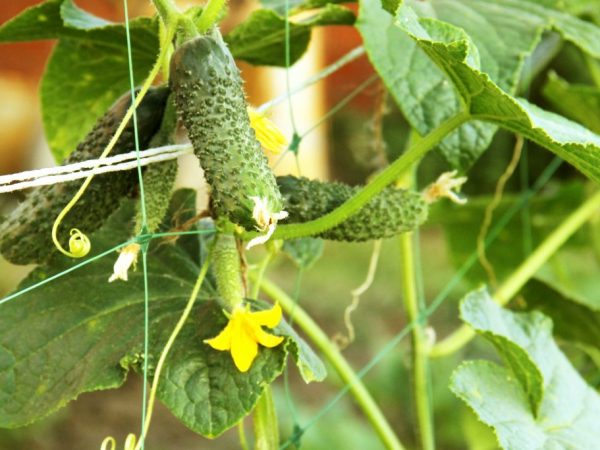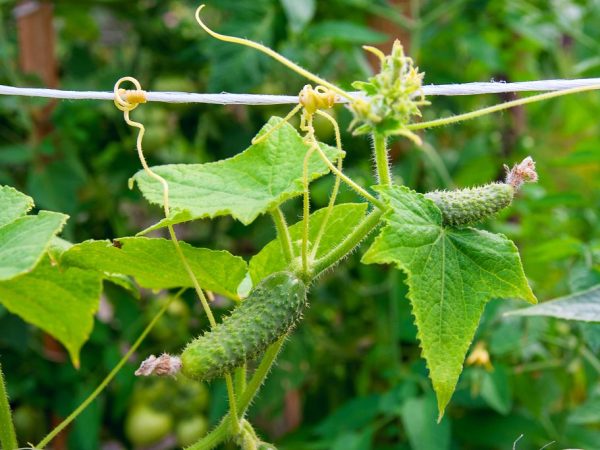How to tie up cucumber bushes correctly
Cucumbers are a culture close to lianas and require a garter due to the peculiarities of their structure and growth. The plant has long stems and the ability to cling to supports suggests upright growth. They use tying in the open field and in greenhouses. In order for the cucumbers to grow as comfortable as possible, you need to understand how to tie cucumbers and what advantages this method has.

Tying cucumbers correctly
Why tie cucumbers
Easy to care for and harvest when crop access is unlimited. Without much inconvenience, you can water, fertilize and treat bushes from diseases or pests. Better to check the condition of the plants. It is much more difficult to carry out such procedures in a garden completely covered with leaves and cucumber stalks lying underfoot.
Good ventilation and gas exchange promotes plant growth. Due to the intake of a sufficient amount of carbon dioxide and oxygen, the processes of photosynthesis proceed without disturbances. And the bushes produce the necessary nutrients (sugar and starch). And also good ventilation serves as a preventive method against mold and rot.
The trellis allows you to plant more bushes in a limited area without harming them. Since all the green mass will be in an upright position, the bushes will not interfere with each other.
Benefits
The main advantages of tying cucumbers:
- improved ventilation and gas exchange;
- saving space;
- prevention of infection with diseases;
- ease of care;
- simplify harvesting.
Outdoor tying
In order not to harm the plant, you need to know exactly how to tie cucumbers correctly and when to do it.
Bushes begin to tie up when they reach 30-35 cm and 4-5 pairs of true leaves are formed. Choose an option that will be convenient for use. There are three main methods for open ground.
- vertical;
- horizontal;
- on the grid.
Let's take a closer look at these options for tying cucumbers, how to make the tapestry correctly and what is needed for this.
Vertical
With vertical growth, contact with the ground is reduced to a minimum. The land is often infested with fungal diseases. And when in contact with it, the chances of getting an infection of the bush increase.
The vertical method involves the installation of two supports at different ends of the bed. Use metal, plastic pipes or wooden sticks. About 2 meters high. If wooden sticks are used, then be sure to treat the ends with specialized means that prevent wood from rotting (for example, Aquatex). They dig in strong supports to a depth of 35-40 cm.
A strong cord or wire is attached between the posts at the maximum height. And from it guide ropes are lowered to each individual bush.If the rope is not "at hand", you can use fabric strips. They are attached to the base of the stem, but not lower than 3 pairs of true leaves, it is important not to tighten the knot on the plant too much so as not to damage it, the loop should be with a margin for growth. The rails can also be fixed to the ground with wire brackets.

The vertical garter method is very convenient
This type of garter is very convenient, it allows you to comfortably grow more plants in a limited area. On such a trellis, cucumber whips rise and weave without problems. If you install a structure on each row of planted cucumbers, you get a very convenient bed, which is easy to care for, monitor the state of the culture, and spray. And harvesting is very convenient, the bushes are better visible, the fruits do not overripe.
The tying of each bush to a separately fixed high support is also referred to as a vertical garter, and tomatoes are also tied up. But in the case of cucumbers, this is not very convenient, you need a lot of high beams, and their installation is a laborious process. With a large set of green mass, such a support can easily collapse, breaking and destroying the plants.
Horizontal
A commonly used type of garter, well suited for medium-sized, low-curling shrubs. Simplifies maintenance and harvesting.
A very simple design with two beams installed along the edges of the beds and a string (rope) stretched between them along the entire height, keeping the distance between the horizontal lines 25-30 cm. Attach the stems to the lower level. For fastening, a rope, fishing line, as well as specialized plastic fasteners and ties for a garter are used.
The disadvantage of this method is that the plant does not always cling to the next level of the stretched rope, but begins to go up. And for this you have to constantly monitor and redirect the whips.
On the grid
A very convenient way to tie cucumbers in modern gardening is a garter on a grid. A special mesh is attached between the two supports. And the cucumbers cling to it perfectly and crawl up. Facilitates the robot and requires a minimum of effort to erect such a trellis.
The grid is mostly green (sometimes white), the size of the cells is 10x10 cm, there are different widths of 1.5 or 2 meters, and the length can be purchased as needed for a particular bed.
Tying in greenhouses
It is very important to tie up cucumbers in the greenhouse, because, being in a confined space, the plant is in particular danger. Possible infection with diseases as a result of disruption of gas exchange and thickening. Many greenhouse varieties require growing on trellises in an upright position. Otherwise, irregularly shaped fruits are formed, such as Teplichny f1, Chinese farmer f1 and others with similar characteristics.
There are several options for tying cucumbers in a greenhouse:
- vertical;
- horizontal;
- dazzling cucumbers;
- V-like.
Vertical and horizontal garters in greenhouses are similar to those used outdoors, as described above.
Let's dwell on other types in more detail.
V-like

With the V-shaped method, the plant is well ventilated.
This tying is done quite simply. The frame of the greenhouse is used for fastening. Fasten strips of fabric or rope to the frame, then lower them to the bush, and attach them to the main and side stem. They are retracted at an angle of 45 degrees and raised upward, attached to the frame. Long strips will be required, they can be tied or sewn together to get sufficient length. This type of garter has proven itself very well in the greenhouse cultivation of cucumbers. The bush is divided into two parts, it is better ventilated, does not thicken, receives a lot of light.
Dazzling cucumbers
A modern method that is increasingly used in gardening and is recommended by professionals.
Based on the plant growth control technique.The main stem is attached to a vertical support, and all lateral processes that grow on the bush above 50 cm are removed. This operation stimulates fruiting on the main stem. Allows the plant not to waste energy on the support and growth of side shoots. Which improves the fruiting and persistence of cucumbers.
Tying in polycarbonate greenhouses
Tying cucumbers in polycarbonate greenhouses has its own characteristics. These greenhouses use two main types of garters:
- vertical;
- horizontal.
The vertical scheme is used in polycarbonate greenhouses with a height of more than two meters. The ropes are fixed to the frame, lowered to the bushes, and fastened to the ground with staples. You can also hammer in wooden pegs next to the bushes and attach ropes to them. The stem is allowed to curl upward.
The horizontal method is suitable for low or arched polycarbonate greenhouses. Supports are driven in at opposite ends, rows are stretched horizontally between them every 25-30 cm. Cucumbers are attached to them and allowed to grow in a horizontal direction.
Thin branches are also used for support, which are attached with the upper part to the frame, and the lower part is fixed in the ground. Cucumbers cling to such branches without problems and twist along them.
Tying with other cultivation methods
Many grow vegetables in the apartment or on the balcony. A tribute to fashion or an invincible desire to grow plants even in the absence of a personal plot. The list of garden plants grown in the apartment also includes cucumbers.
Potted cucumbers also require a garter.
Consider several ways how to properly tie cucumbers on the balcony.
- Use different ladders, props (wooden, plastic), the choice in flower shops is sufficient.
- Fasten several thin supports in a pot in a circle, you can use window glazing beads (you can find them in hardware stores). And dividing the bush into lashes, attach it to these supports.
- Can serve as a trellis for cucumbers on the balcony and clothesline, to which the cords are attached and lowered to the bushes.
Conclusion
The advantage of growing cucumbers by tying them to different types of supports and trellises is obvious. There is not much time and effort spent on this process, but the benefits are enormous. A timely and high-quality garter will give a good result and a high yield.


